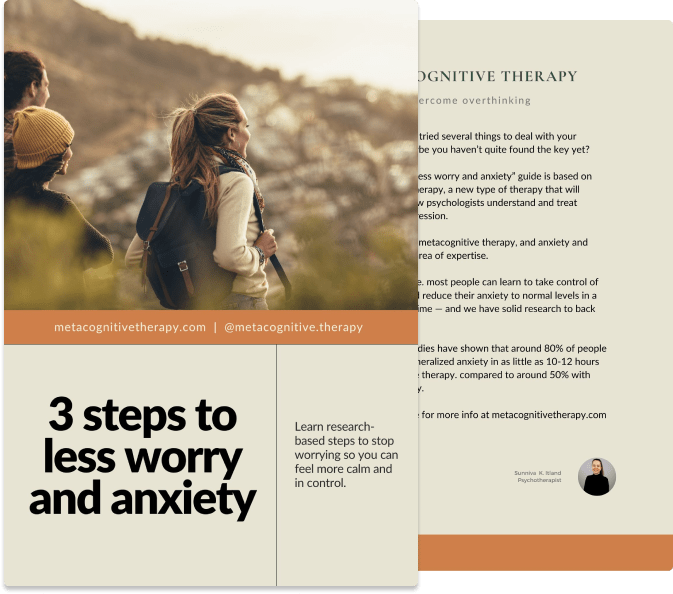Do you have high-functioning anxiety? Unmasking signs of the overachiever’s anxiety

Download our best tips on reducing anxiety and worrying
Learn three powerful metacognitive therapy steps to stop the worry cycle, reduce anxiety, and feel calmer in everyday life.
.jpeg)
.jpeg)
High-functioning anxiety can be a quiet struggle, that often hides behind outward success. From the outside, people with high-functioning anxiety seem like they have it all together.
They tend to have solid careers, strong relationships, they’re reliable, productive, and usually appear composed and confident. But underneath the calm exterior, there’s often a constant undercurrent of relentless worry, self-doubt, and fear of not being good enough.
While high-functioning anxiety isn't an official diagnosis (it typically falls under generalized anxiety disorder), it can coexist with other anxiety conditions like panic disorder, social anxiety, or health anxiety. Symptoms can include racing thoughts, heart palpitations, muscle tension, headaches, and feelings of impending doom. The key difference here is in the invisible nature of their struggles, and the fact that instead of avoiding situations they fear, people with high-functioning anxiety tend to lean into them and overperform.
The coping mechanisms that fuel success (and stress)
For many, anxiety fuels achievement. People with high-functioning anxiety compensate for their internal discomfort by becoming overly structured, hyper-organized, and constantly productive. They plan excessively, prepare for every possible outcome, and work hard to prevent mistakes. Sound familiar?
Instead of avoiding stressful activities, they develop coping strategies that drive both their success and their suffering, with meticulous planning, and perfectionism. They frequently become experts in every domain of their lives, from parenting to career to relationships, so they can stay ahead of potential problems.
These coping strategies can be effective — at least temporarily. This approach often leads to a lot of praise and external validation. Friends and colleagues admire their discipline and capability. But this feedback creates a trap: it reinforces that over-performing and constant vigilance is necessary, so letting go of their strategies can feel like dismantling their identity and success. This constant striving is exhausting and often unsustainable, which can ultimately lead people to feel burned out and chronically stressed.

Download our best tips on reducing anxiety and worrying
Learn three powerful metacognitive therapy steps to stop the worry cycle, reduce anxiety, and feel calmer in everyday life.
The inner experience: control, self-criticism, and fear
People with high-functioning anxiety often wrestle with self-criticism and imposter syndrome, convinced they're never quite good enough. The fear of being 'found out' as inadequate drives them to maintain their hypervigilence.
Many describe feeling unable to relax, as though sitting still would allow all of their anxiety to surface. Because they’re afraid of things falling apart, they cling to control. They may feel like they need to fix, plan, or “do” constantly, believing that if they can just stay on top of everything, the anxiety will subside. But relief rarely comes, and their pursuit of perfection becomes a way to manage low self-esteem.
Why traditional therapy often doesn’t help, and what actually works
Traditional therapy typically falls short for people with high-functioning anxiety. Many find themselves mentally outpacing their therapists — approaches that focus on reassurance, mirroring or problem-solving can feel redundant to someone who already spends most of their time analyzing, preparing, and troubleshooting. They might even come to therapy having already tried every strategy suggested.
Metacognitive Therapy (MCT) offers a different, particularly effective approach: Instead of focusing on the content of thoughts (“What if I fail? What if I’m not enough?”), MCT zooms out to look at the thinking process itself — how much time are you spending worrying, monitoring, or trying to control your thoughts?
MCT helps people with high-functioning anxiety learn that they can function and succeed without the constant overthinking and over-preparing. Through techniques like detached mindfulness, you can practice noticing anxious thoughts without engaging with them. Instead of analyzing or solving the worry, you allow it to come and go naturally.
Letting go and doing less
Rather than restructuring thoughts, writing down worries, measuring your mood and using relaxation techniques, MCT encourages the opposite: learning to do less. It can feel uncomfortable to release over-preparing and perfectionism, but most people find it passes as they learn to leave these feelings alone. The goal is discovering that you can let anxious feelings and thoughts pass on their own, rather than immediately trying to eliminate them through productivity. This essentially helps you see that performance and success don’t depend on worry and control. You can still meet your responsibilities and thrive at work and in your personal life, without the mental burden of overthinking and over-planning.
Letting go of these habits can feel risky… treatment requires gradual experimentation and a willingness to test whether things really will fall apart without excessive preparation. But most people find that they ultimately function better, and at a sustainable pace, with less stress and more time for other things that matter to them.
High-functioning anxiety thrives on the illusion that worry equals safety and control. If you’re ready to dismantle that illusion, try booking a Metacognitive Therapy session with a certified therapist to finally find freedom from overthinking.



